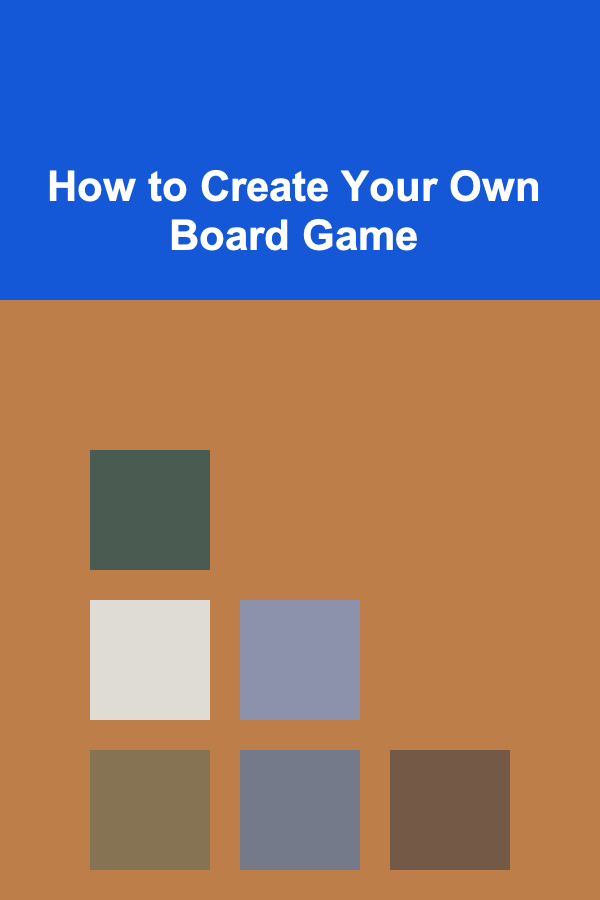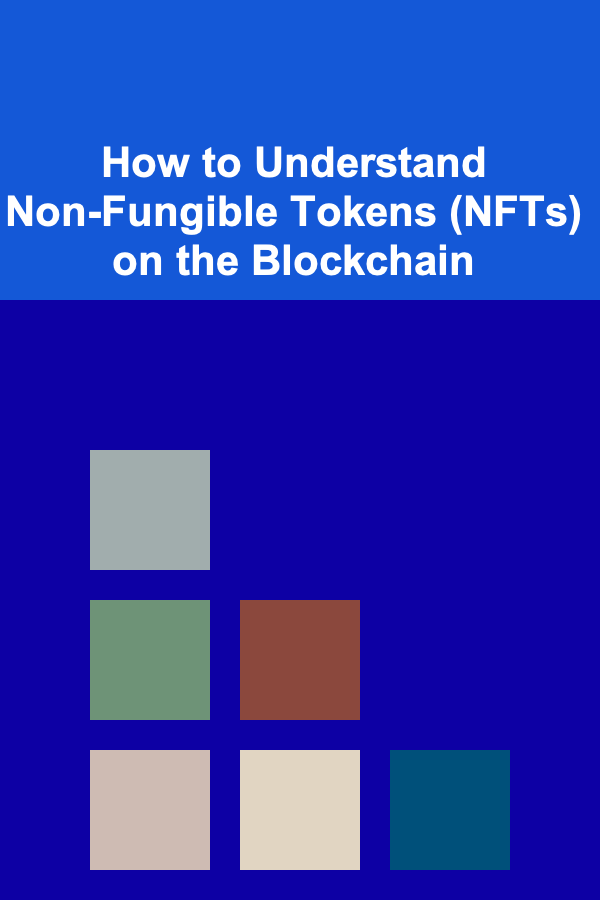
How to Create Your Own Board Game
ebook include PDF & Audio bundle (Micro Guide)
$12.99$11.99
Limited Time Offer! Order within the next:

Board games have been a source of entertainment, learning, and social interaction for centuries. Whether you're playing with family, friends, or even strangers, a great board game can bring people together and create lasting memories. If you've ever found yourself playing a game and thinking, "I could make something better," you're not alone. Creating your own board game is a rewarding process that allows you to craft a unique experience for others to enjoy. But how do you turn that spark of creativity into a fully functional and enjoyable game?
This guide will walk you through the process of creating your own board game from scratch, covering everything from the initial concept to playtesting and final production. Let's dive into the world of board game design and discover how you can make your very own game!
Conceptualizing Your Game Idea
The first step in designing a board game is to come up with an idea. This is the foundation upon which everything else will be built, so take your time and think it through. A well-defined concept can make the difference between a fun and engaging game and one that feels forced or disjointed.
What Kind of Game Do You Want to Create?
Before diving into mechanics and rules, think about the kind of experience you want your game to deliver. Ask yourself these questions:
- Is your game competitive or cooperative? Competitive games pit players against each other to achieve a goal, while cooperative games require players to work together to succeed.
- What is the theme? A theme can help set the tone for your game and can be anything from fantasy, history, science fiction, to something abstract like emotion or time.
- How many players? The number of players can greatly affect the game's mechanics. Do you want a game for two players, a large group, or something for a solo experience?
- What age group are you targeting? Knowing your audience will help determine the complexity of the game, the artwork, and the overall design. Games for younger players tend to have simpler rules, while games for older players can introduce more strategic elements.
Define the Core Gameplay
The core gameplay is the driving force behind your board game. It's what makes the game fun and engaging. At this stage, think about how players will interact with the game world. What actions will they take? Will they be rolling dice, drawing cards, building strategies, or making decisions that affect the outcome?
For example, in a strategy game like Settlers of Catan , players must gather resources, trade with others, and build settlements. In a party game like Codenames, players give and guess clues based on word associations.
Start simple, focusing on a few core mechanics. As you go along, you can always expand or modify them. But having a clear vision of the main interaction will give your game direction.
Designing the Game Components
Once you have a basic concept, it's time to design the components that will bring your game to life. Every board game has unique elements, whether it's a game board, cards, dice, tokens, or miniatures. These elements should complement the mechanics and theme of the game.
The Game Board
The board is often the most important component in a board game, and how it's designed depends on your game's mechanics and theme. Here are a few types of board designs:
- Modular Boards : Games like Carcassonne use a modular board, where pieces are placed together during gameplay. This creates variety in each playthrough and can change the game's dynamics each time.
- Fixed Boards : Games like Monopoly have a fixed board where the layout remains the same each time you play. This creates a predictable structure and can focus more on strategy than randomness.
- Abstract Layouts : Games like Twilight Struggle have boards that represent different territories or areas, but these aren't based on real-world maps. These abstract boards are often used in strategy games and offer flexibility in gameplay.
Cards and Other Components
Cards can introduce randomness and depth into your game. For example, they can provide new challenges, items, or event triggers. Some games, like Magic: The Gathering, rely heavily on cards, while others might use them for simple mechanics like drawing from a deck to move or trigger special actions.
Other components might include:
- Tokens: These can represent money, points, units, or anything else the game needs.
- Dice: Dice add an element of chance, allowing for varied outcomes in each round.
- Miniatures: These are often used in more complex games to represent characters or objects on the board.
Aesthetics and Artwork
The visuals of your game are not just about making it look nice; they also enhance the game's experience. Great artwork helps immerse players in the theme, making the game more engaging. If you are not an artist, consider collaborating with someone who can help bring your vision to life. Don't forget to design clear icons and symbols for easy understanding of the game mechanics.
Writing the Rules
Clear, concise rules are essential for any successful board game. Without a solid rulebook, players may feel confused or frustrated, which can ruin the game experience. Writing the rules can be a daunting task, but it's a necessary step in the design process.
Structure of the Rulebook
A good rulebook typically includes the following sections:
- Objective of the Game: What is the goal? For example, "The first player to reach 10 points wins."
- Setup: How do you prepare the game for play? Describe how to set up the game components and what each player needs to do before starting.
- Gameplay: This is the meat of the rulebook. Explain how players will take turns, what actions they can perform, and how the game progresses.
- Winning the Game: Describe how the game ends and what conditions need to be met for a player to win.
- Advanced Rules (if any): If your game has advanced mechanics or special rules, this is the section where you can explain them.
- Examples: Providing examples of gameplay can help players better understand how the game works.
Playtesting the Rules
Once your rules are written, it's time to put them to the test. Playtesting is a crucial part of game design because it lets you see how your rules work in practice. During a playtest, watch closely for any areas of confusion or mechanics that don't quite work.
- Playtest with Different Groups: Playtesting with people who are unfamiliar with your game is essential. This helps you identify unclear rules or parts of the game that aren't fun.
- Refine the Rules: After each round of playtesting, make necessary adjustments to the rules. This could involve tweaking the game mechanics, rewording certain instructions, or adding additional clarification.
Prototyping and Production
Once you're satisfied with the gameplay and rules, it's time to make a prototype of your board game. A prototype is a rough version of the game that you can use to further test its functionality. At this stage, don't worry about fancy materials or high-quality production. The goal is to test how well your game works.
Making a Prototype
You can create a prototype using basic materials like paper, index cards, and markers. For example:
- Game Board: Draw the layout on a large sheet of paper or cardboard.
- Cards: Use index cards or regular playing cards and write your game mechanics on them.
- Pieces: You can use any small objects like coins, buttons, or tokens for the game's pieces.
Once your prototype is ready, gather a group of friends or family to test it out. Play through the game and make note of any issues that arise.
Refining the Prototype
During this phase, you may notice some components that aren't working as expected, and this is perfectly normal. It's important to tweak and refine the game based on feedback from playtesters. Pay attention to things like game balance, pacing, and player engagement. Be prepared to make adjustments to the rules, game board, and components.
Final Production
When you're confident that your game is in its final form, it's time to think about production. There are several ways to produce a physical copy of your game:
- Print-on-Demand : Services like The Game Crafter allow you to upload your designs and have physical copies printed and shipped.
- Crowdfunding : Platforms like Kickstarter can help you raise funds to produce and distribute your game to a wider audience.
- Manufacturers: If you want to mass-produce your game, you can contact board game manufacturers who specialize in creating custom games.
Marketing and Distribution
Creating the game is only half the battle; getting it into the hands of players is the next challenge. To successfully market and distribute your game, you'll need to build awareness and attract potential customers.
Creating a Buzz
- Create a Website: Having a website dedicated to your game can help build a community and keep players informed about updates, expansions, and where to buy the game.
- Social Media: Use platforms like Instagram, Twitter, and Facebook to post updates, share gameplay videos, and connect with your audience.
- Collaborations: Reach out to bloggers, YouTubers, and other influencers in the board game community to review your game and help spread the word.
Distribution Channels
Consider selling your game through platforms like Amazon , Etsy , or BoardGameGeek. You can also partner with local game stores or conventions to showcase your game.
Conclusion
Creating a board game is an exciting and rewarding process that combines creativity, strategy, and design. From developing the core mechanics to fine-tuning the rules, every step is an opportunity to craft something unique and fun. Whether you're making a game for friends and family or aiming to publish it for a global audience, the journey of creating your own board game is a deeply fulfilling one.
By following these steps and embracing the iterative nature of game design, you'll be well on your way to creating a game that's not only fun to play but also a piece of art that can stand the test of time. So, gather your materials, start brainstorming, and get ready to bring your game to life!
Reading More From Our Other Websites
- [Home Budget 101] How to Organize Your Home to Save Money and Stay Clutter-Free
- [Home Space Saving 101] How to Conquer Under-Sink Chaos: Clever Storage Solutions for Bathrooms and Kitchens
- [Home Family Activity 101] How to Create a Family Fitness Challenge That Keeps Everyone Active and Motivated
- [Organization Tip 101] How to Set Up a Pet Supply Donation System
- [Home Storage Solution 101] How to Use Baskets and Containers for Tidy Spaces
- [Organization Tip 101] How to Organize Leftover Recipes for Efficient Use
- [Home Family Activity 101] How to Plan a Family Spa Day Without Leaving the House
- [Organization Tip 101] How to Sort and Store Sports Gear for Different Activities
- [Home Family Activity 101] How to Build a Home Obstacle Course for Active Family Fun
- [Paragliding Tip 101] Understanding Coverage Options: Liability, Accident, and Equipment Protection for Paragliders

How to Leverage Deep Learning to Build a Profitable Side Hustle
Read More
How to Use the Seinfeld Method for Consistency
Read More
Top DIY Home Repairs and Improvements That Increase Property Value
Read More
How to Understand Self-Assembling Machines
Read More
How to Understand Non-Fungible Tokens (NFTs) on the Blockchain
Read More
10 Tips for Wine Tasting on a Budget
Read MoreOther Products

How to Leverage Deep Learning to Build a Profitable Side Hustle
Read More
How to Use the Seinfeld Method for Consistency
Read More
Top DIY Home Repairs and Improvements That Increase Property Value
Read More
How to Understand Self-Assembling Machines
Read More
How to Understand Non-Fungible Tokens (NFTs) on the Blockchain
Read More